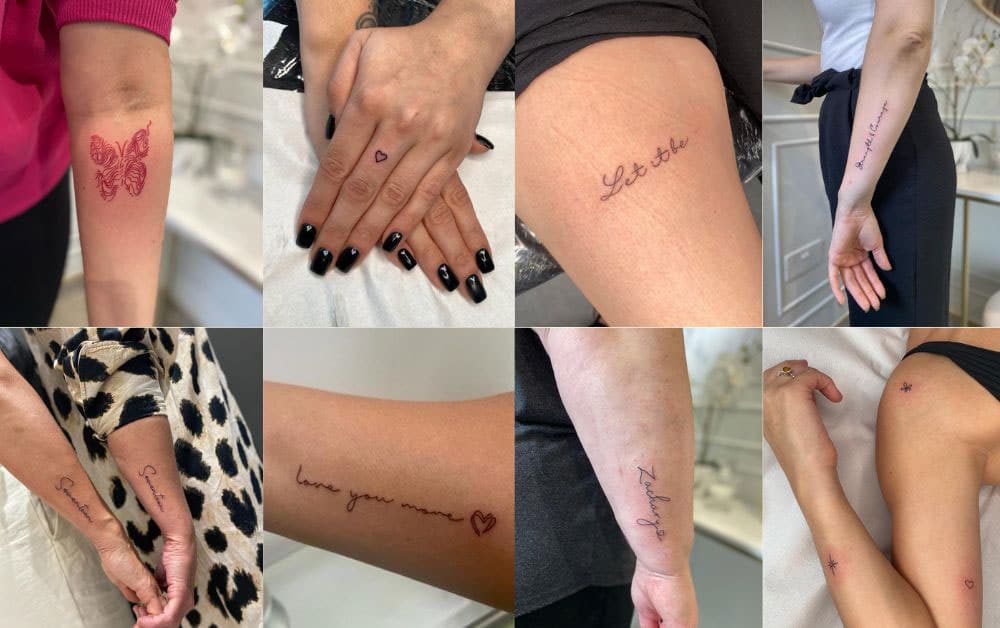In the realm of body art, tattoos have long been cherished as a means of self-expression and storytelling. While bold and vibrant designs have dominated the tattoo scene for decades, there has been a surge in popularity for a more delicate and intricate style known as fine line tattoos. In this blog post, we will explore why fine line tattoos have captured the hearts of many customers looking for a refined and feminine tattoo option. We’ll also delve into the advantages of choosing clinic environments over traditional tattoo shops, discover who specialises in fine line tattoos, examine the pain factor involved, discuss healing times, address concerns about permanence, and clarify age restrictions. So, whether you’re an avid tattoo enthusiast or contemplating your first piece of body art, join us on this journey into the mesmerising world of fine line tattoos.
Why have fine line tattoos become so popular?
Fine line tattoos have recently gained immense popularity due to their elegant and timeless aesthetic appeal. Unlike traditional bold designs that rely on thick outlines and vibrant colours, fine line tattoos embrace simplicity through intricately detailed lines that create striking images with minimalist charm. These delicate designs not only accentuate the natural contours of the body but also allow for greater versatility when it comes to placement options.
Moreover, fine line tattoos offer a unique sense of sophistication that resonates particularly well with those seeking a feminine touch or a more discreet form of self-expression. By using thinner needles and precise techniques, talented artists can create intricate patterns ranging from dainty flowers to delicate script. This attention to detail results in stunning works of art that are both captivating and visually alluring.
Why choose a clinic environment over a traditional tattoo shop?
In recent years, there has been a noticeable shift towards customers opting for clinic environments over traditional tattoo shops when it comes to getting their fine line tattoos. This choice is often driven by several factors that contribute to a more comfortable and reassuring experience.
Clinics specialising in fine line tattoos, such as the renowned Carly Kent Ongar Clinic, provide an environment that prioritises cleanliness, professionalism, and customer satisfaction. These dedicated spaces offer a departure from the bustling atmosphere of traditional tattoo parlours, providing a serene and calming ambiance for clients. The clinic environment ensures meticulous hygiene practices and adheres to strict safety protocols, offering peace of mind throughout the tattooing process.
Additionally, clinic environments often foster closer collaboration between artists and clients. Artists who specialise in fine line tattoos take the time to understand their clients’ vision, allowing for personalised designs that perfectly reflect their individual style and preferences. This level of attention to detail creates an intimate and collaborative experience that sets clinic environments.
The Artists Behind Fine Line Tattoos
Fine line tattoos require a skilled hand and an eye for precision. Talented artists with expertise in this delicate art form are at the forefront of this growing trend. Many have honed their skills through years of practice and have developed a distinct style that sets them apart.
Within the community of fine line tattoo artists, each individual possesses their own unique style and artistic flair. Some may specialise in botanical illustrations, while others excel in delicate lettering or minimalist portraits. No matter your preference, there is undoubtedly an artist out there whose style aligns perfectly with your desired aesthetic.
Are fine line tattoos painful?
The fear of pain is often a significant concern when it comes to getting a tattoo—especially one as intricate as a fine line design. However, it’s essential to understand that pain is subjective and can vary depending on individual tolerance levels.
In general, due to the use of thinner needles, fine line tattoos tend to be less painful than their bolder counterparts. The needle’s delicate touch creates a sensation akin to a scratching or stinging feeling rather than deep discomfort. Many individuals describe the experience as bearable and surprisingly manageable.
Moreover, reputable artists take great care in ensuring their clients’ comfort throughout the process. They may offer numbing creams or provide breaks during longer sessions to minimise any discomfort. Open communication with your artist regarding pain tolerance and concerns will help create a more relaxed and positive tattooing experience.
How long do fine line tattoos take to heal?
After getting a fine line tattoo, it’s crucial to understand that proper aftercare is essential for optimal healing and long-lasting results. While each person’s healing process can vary slightly, there are general guidelines to follow.
Initially, you may experience mild redness and swelling around the tattooed area. This is entirely normal and should subside within a few days. It’s important not to pick or scratch at the healing tattoo, as this can lead to complications such as infection or colour loss.
Fine line tattoos typically take around two weeks to heal fully. During this time, it’s vital to keep the area clean by gently washing with mild soap and water and applying an appropriate aftercare ointment recommended by your artist. Avoid exposing the tattooed area to prolonged sunlight or soaking in bodies of water such as pools or baths until it has completely healed.
Remember that patience is key during the healing process. With proper care, you will be rewarded with a beautifully healed fine line tattoo that will stand the test of time.

